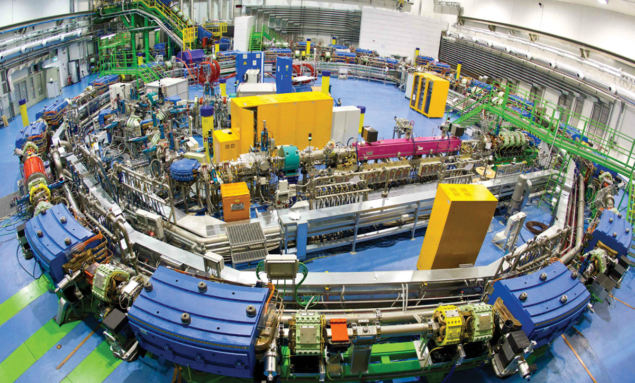
In a clinical world-first, a proton beam has been used to treat a patient with a ventricular tachycardia, which causes unsynchronised electrical impulses that prevent the heart from pumping blood. On 13 December, a 150 MeV beam of protons was directed at a portion of tissue in the heart of a 73-year-old male patient at the National Center of Oncological Hadrontherapy (CNAO) in Italy – a facility set out 25 years ago by the TERA Foundation and rooted in accelerator technologies developed in conjunction with CERN via the Proton Ion Medical Machine Study (PIMMS). The successful procedure had a minimal impact on the delicate surrounding tissues, and marks a new path in the rapidly evolving field of hadron therapy.
The use of proton beams in radiation oncology, first proposed in 1946 by founding director of Fermilab Robert Wilson, allows a large dose to be deposited in a small and well-targeted volume, reducing damage to healthy tissue surrounding a tumour and thereby reducing side effects. Upwards of 170,000 cancer patients have benefitted from proton therapy at almost 100 centres worldwide, and demand continues to grow (CERN Courier January/February 2018 p32).
The choice by clinicians in Italy to use protons to treat a cardiac pathology was born out of necessity to fight an aggressive form of ventricular tachycardia that had not responded effectively to traditional treatments. The idea is that the Bragg peak typical of light charged ions (by which a beam can deposit a large amount of energy in a small region) can produce small scars in the heart tissues similar to the ones caused by the standard invasive technique of RF cardiac ablation. “To date, the use of heavy particles (protons, carbon ions) in this area has been documented in the international scientific literature only on animal models,” said Roberto Rordorf, head of arrhythmology at San Matteo Hospital, in a press release on 22 January. “The Pavia procedure appears to be the first in the world to be performed on humans and the first results are truly encouraging. For this reason, together with CNAO we are evaluating the feasibility of an experimental clinical study.”
Hadron therapy for all
CNAO is one of just six next-generation particle-therapy centres in the world capable of generating beams of protons and carbon ions, which are biologically more effective than protons in the treatment of radioresistant tumours. The PIMMS programme from which the accelerator design emerged, carried out at CERN from 1996 to 2000, aimed to design a synchrotron optimised for ion therapy (CERN Courier January/February 2018 p25). The first dual-ion treatment centre in Europe was the Heidelberg Ion-Beam Therapy Centre (HIT) in Germany, designed by GSI, which treated its first patient in 2009. CNAO followed in 2011 and then the Marburg Ion-Beam Therapy Centre in Germany (built by Siemens and operated by Heidelberg University Hospital since 2015). Finally, MedAustron in Austria, based on the PIMMS design, has been operational since 2016. Last year, CERN launched the Next Ion Medical Machine Study (NIMMS) as a continuation of PIMMS to carry out R&D into the superconducting magnets, linacs and gantries for advanced hadron therapy. NIMMS will also explore ways to reduce the cost and footprint of hadron therapy centres, allowing more people in different regions to benefit from the treatment (CERN Courier March 2017 p31).
I think that in 20 years’ time cardiac arrhythmias will be mostly treated with light-ion accelerators
“When I decided to leave the spokesmanship of the DELPHI collaboration to devote my time to cancer therapy with light-ion beams I could not imagine that, 30 years later, I would have witnessed the treatment of a ventricular tachycardia with a proton beam and, moreover, that this event would have taken place at CNAO, a facility that has its roots at CERN,” says TERA founder Ugo Amaldi. “The proton treatment recently announced, proposed to CNAO by cardiologists of the close-by San Matteo Hospital to save the life of a seriously ill patient, is a turning point. Since light-ion ablation is non-invasive and less expensive than the standard catheter ablation, I think that in 20 years’ time cardiac arrhythmias will be mostly treated with light-ion accelerators. For this reason, TERA has secured a patent on the use of ion linacs for heart treatments.”







